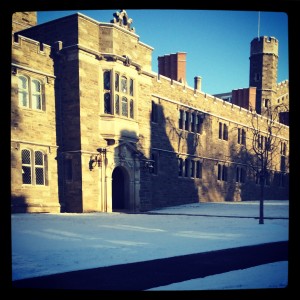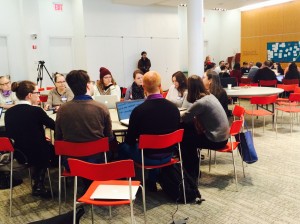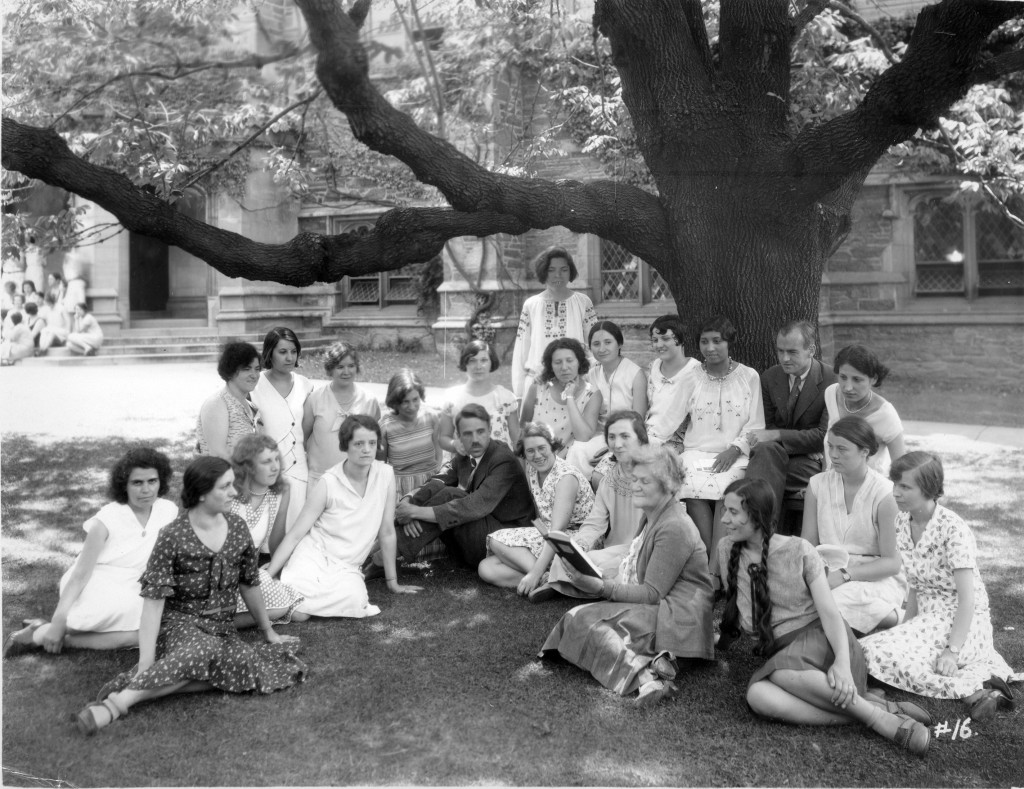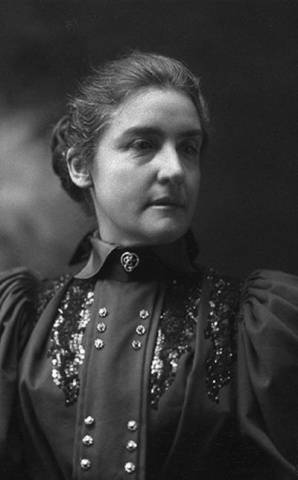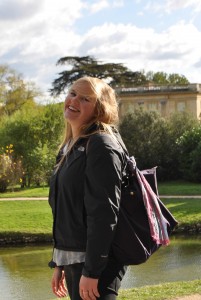Tag Archives: Reflecting on the history of women’s education
Finding Religion at College? Documenting the History of Women in Higher Education
Featured
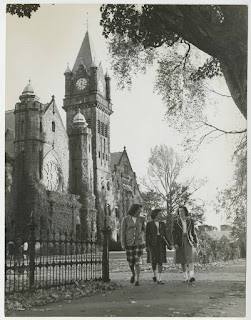
Mount Holyoke students walking by Abbey Chapel, ca. 1940s. Mount Holyoke College Archives and Special Collections, via collegewomen.org.
After returning from the Digital Library Federation Forum in Vancouver, I reflected on one of the College Women site’s lesser themes, religion. How might we go about studying religion at the women’s colleges?
As someone who has studied, taught, and written about American religion and American women’s higher education separately for quite some time, I’m intrigued by conversations about the place of religion on college campuses, in both the built environment and the curriculum. Our Seven Sisters digital project (collegewomen.org) and conversations with my students who participate in religious life on the 21st-century campus show me new ways of continuing these lines of inquiry, in the College Archives and in our new virtual portal.
Read more over at Religion in American History: Finding Religion at College? Documenting the History of Women in Higher Education. [link]
Black at Bryn Mawr: What’s Next?
Featured
* cross-posted from the Black at Bryn Mawr blog *

Good question!
I’ve been invited by the Bryn Mawr College Pensby Center to kick off this year’s Diversity Conversations programming – this Wednesday, September 30 at noon – with a look at the past, present, and future of the Black at Bryn Mawr project. During 2015-2016, I will continue to manage the project, providing new research and integrating it with my teaching and the work of the Greenfield Digital Center. I feel the loss of the project’s creators, Emma Kioko ’15 and Grace Pusey ’15 greatly — their energy and expertise made Emma’s idea for a Black history walking tour real, and far more successful than we ever could have imagined at this time last year. Our students graduate, and move on in their research and careers; talk of sustainability for campus history projects in the small liberal arts college environment must reflect this.
For those who can not attend the conversation, I am making my slides available via Slideshare (click here) and welcome comments and further questions below. Today’s presentation also dovetails with the work I am just beginning as a co-organizer of the 2016 NCPH Working Group “Campus History as Public History,” which is taking applications through October 15, 2015. Can we create best practices for these kinds of projects?
As always, the conversation also continues on Twitter: #BlackatBrynMawr and #campushistories.
“I never knew what I might find in the boxes”: Temple University student David Polanco on Archives and Teaching
This blog post has been written by David Polanco, one of two Temple University students who discovered Bryn Mawr Special Collections last Fall as part of the Greenfield Digital Center’s third year participating in the Cultural Fieldwork Initiative organized by Greenfield Digital Center Advisory Board member and Temple University historian Christine Woyshner. David spent his semester researching the history of women’s sports and women’s colleges — a topic of continuing relevance to both students and the general public.
My field experience at Bryn Mawr College Special Collections was a great one. They manage extensive collections of art, artifacts, rare books, manuscripts, and photographs, and also have a wide-ranging digital archive on the history of women’s education, and resource guides. The Greenfield Digital Center’s online gateway has digital primary resources, instructional activities, and opportunities for teachers and students.
One of the reasons why Bryn Mawr was my top choice [for the Cultural Fieldwork Initiative placement] was because of the chance to learn more about women’s education. Women’s history usually gets lost in the shuffle when teachers teach U.S. History classes. Women are a huge part of the fabric of American history and Bryn Mawr College is a great resource. Continue reading
Sharing Our Work: Reflections on Digital History for the New Year
Featured
Last week, I returned to Bryn Mawr after nearly a week in New York for the annual meeting of the American Historical Association (AHA). My meeting was a busy one — catching up with old friends and mentors, checking in with one of my other professional organizations (the Coordinating Council for Women in History), helping to organize THATCamp AHA, and chairing a panel on feminist work in digital history. It was an exhilarating and exhausting week. But despite the conference fatigue, I left New York feeling energized for the work I’ll be taking on for the Greenfield Center this semester: teaching my first course, Higher Education for Women: Bryn Mawr and Beyond; advising students doing archives fieldwork as part of Bryn Mawr’s Praxis program; continuing to work on the NEH-funded Seven Sisters digital project; and planning our May conference, Women’s History in the Digital World 2015.
Perhaps because our conference CFP is due later this week, I spent a lot of time at AHA thinking about how conferences bring us together, and about how we can support each other and build audiences for our work. I spent much of my time on Twitter, like my colleague Shane Landrum, who argues, “Live-tweeting #AHA2015 is, for me, a way to turn note-taking into a tiny bit of professional service [and] make what we do more public and visible.” It is also a way for me to promote digital projects that don’t always receive attention (or funding).
So that’s how I found myself, for the first time, live-tweeting while seated as panel chair at Session 159: Can DH Answer Our Questions: Using Digital Humanities to Address the Concerns of Feminist Historians. To audience members unfamiliar with the ways of the #twitterstorians, it would have looked surprising to see a panel chair typing away during each speaker’s presentation, but in a meeting as heavily tweeted as AHA, I wanted the research of our three scholars — panel organizer Kathryn Falvo, Tamika Richeson, and Wendy E. Chmielewski — to be captured and shared as widely as possible. Indeed, the Storify that Kate Moore created to record our session serves as a useful tool for circulating the discussion beyond our conference room.
As the panelists made their remarks, I found myself scribbling down a new conclusion to my comments:
This panel convinces me more than ever before that we shouldn’t have to fear the loss or muting of women’s voices — both scholars and historical subjects — in the rise of digital history, but we do need to continue to be vigilant about getting our work out there. Over the weekend, I’ve been eyeing the digital workshop, sessions, lightning rounds, posters, and proposals coming in for Tuesday’s THATCamp, and I’ve been thinking critically about the digital projects drawing the most attention and conversation. Do they take seriously histories of women, of gender, or sexuality? There’s a reason you may have seen me tweeting during these presentation: We have to be researchers, digital historians, and promoters.
Michelle Moravec, who spoke at AHA about her practice of writing in public, made a similar point:
In that spirit, I’d like to share just a few of the digital projects dealing with histories of women, gender, and sexuality that caught my eye at AHA this year:
- Her Hat Was In the Ring! U.S. Women Who Ran For Political Office Before 1920, created by created by Wendy E. Chmielewski, Jill Norgren, and Kristen Gwinn-Becker
- #QSWG, The Queering Slavery Working Group, organized by Vanessa Holden and Jessica Marie Johnson
- The Shirley Chisholm Project: Brooklyn Women’s Activism from 1945 to the Present, founded by Barbara Winslow
- United States of AIDS, led by undergraduate researchers Guy Greenberg and Norma Juarez (and supervised by Women’s History in the Digital World keynote speaker Claire Potter)
If you have a project to share, or are looking for possible collaborators and conversation partners, I encourage you to submit to Women’s History in the Digital World this week, and to save the conference dates: May 21-22, 2015. I’m excited that the Greenfield Center can play a role in the work of promoting diverse projects in digital history; in the coming weeks, we’ll be sharing details on scheduling, registration, and accommodations. In the meantime, we welcome your ideas and questions — in the comments below, or via email to greenfieldhwe [at] brynmawr [dot] edu.
“Women’s Colleges: Necessary and Invaluable” – Essay Competition Winner Erica Rice Reflects on Women’s Education
“There is no greater inspirational force than that which comes from surrounding
oneself with individuals whom she admires.”
We are excited to announce the first of the two winners of the third annual essay competition of The Albert M. Greenfield Digital Center for the History of Women’s Education, sponsored by The Friends of the Bryn Mawr College Library. Our student winner, freshman Erica Rice, responded thoughtfully to the prompt “Women, education and the future… what do women’s colleges have to offer?” In her essay, she asserts that “equality means not only the freedom to be the same, but also very much the freedom to be different.” The benefits to be reaped from a women’s college education are not a uniform commodity, but are rather the extent to which the college culture and experience allow each individual to avidly pursue a chosen path and excel in the areas in which she is most passionate. Congratulations, Erica!…
Women’s Colleges:
Necessary and Invaluable
The college experience can very easily become a paradox, as a college education should be what equips a young person to accomplish whatever they wish, yet during the time spent earning a diploma, a great deal of pruning other dreams and aspirations is necessary to earn the title of college graduate. The ability to focus and make decisions about one’s future is indeed important, but all too often in the college setting, in the process of becoming a college graduate, pieces of the individual dissolve. Colleges and universities have plenty to offer the future, but people have more. At women’s colleges, the student body is made up of individuals willing to identify as different and who believe that it is their individual aspirations combined with a college diploma that will be what changes their world. The college experience for these women will be a tool, not an identity; because their identity is something they are not willing to compromise.
In addition to bringing together an impressive and self-selecting group of individuals, the experience of women’s colleges is a precious commodity that will become no less important in the future. That women have come to assert themselves as intellectual assets on college campuses across the world is wonderfully exciting and an absolutely necessary aspect of global progress in every way. Leveling the gender discrepancy in education continues to be a process that demands the support of groups and individuals in every sector. However, it is vital to remember that equality means not only the freedom to be the same, but also very much the freedom to be different. This is where the experience of women’s colleges is so important. Women’s colleges provide that opportunity to both learn and live as part of a community aware of both its uniqueness as well as its absolute viability in an academic setting without ever asking the individual to sacrifice her identity as she knows it.
This corner of the educational landscape is incredibly valuable and that it be preserved is necessary. As a member of such a community, I can speak personally to the value of the institution of a women’s college. By making the decision to be a part of a community which is so deliberately unique, I have placed myself among the ranks of women who are united in our common goal of wanting to be agents of change and progress in our worlds. There is no greater inspirational force than that which comes from surrounding oneself with individuals whom she admires. At women’s colleges, peers serve as motivators because passion is contagious and I have experienced no shortage in a women’s college community.
Women who make the choice to attend all women’s colleges do not do so with the intention of being ignored. We plunge into our identities as we see them with confidence and live in our community with purpose. At women’s colleges, the product is not simply a college graduate. Rather, women’s colleges produce something far more influential: educated women who have reached their respective goals in their own ways. Women of this kind are what shape the world and that they have every resource to cultivate their aspirations is crucial. The accomplishments of graduates of women’s colleges are too many to count, as will be the contributions of future women in these institutions. Some things, however, are certain: these institutions offer something to their students that is unique and precious, and the world waits with bated breath for what the individuals who make these colleges what they are will offer next.
…
Do you have thoughts about the place of the women’s college in the twenty-first century educational landscape? Have there been aspects of your experience that have shaped your understanding of education for women in the world today? Respond in the comments, or tweet us @GreenfieldHWE!
A new beginning for the Center…
Featured
This blog post brings news that is both sad and exciting for me… after a very productive, educational and inspirational time as Director of The Albert M. Greenfield Digital Center for the History of Women’s Education, I will be moving on as of September 25th 2013. I will be taking up a new faculty post at the National University of Ireland Maynooth in the history department. I have thoroughly enjoyed my time at Bryn Mawr and have learned a lot, getting to immerse myself in the world of digital humanities while pursuing my love of women’s history – bliss! I will be able to continue my work blending digital humanities with pedagogy in my new role and look forward to integrating much of what I’ve learned here.
I especially enjoyed connecting with so many wonderful colleagues on Twitter, some of whom I was lucky to meet in person at the Women’s History in the Digital World conference last March (for a report on the conference click here). The digital repository that resulted from the conference continues to remain popular: it now holds 42 records, which have been downloaded a total of 482 times to date. I do get to remain connected to the Center, however, as I will be joining the Advisory Board. In this capacity I hope to help advise the new Director and to assist in moving the Center on to its next phase of development. The Center has been my focus over the last two years and I am delighted to be able to remain a part of its future. The Center’s growth has been tremendous – we now have 1252 items on the site, and since its launch in September 2012, the website has been viewed by over 41,000 people. The blog, Educating Women, has had over 25,000 page views and continues to attract new followers – be sure to keep up to date with news from the Center by visiting the blog regularly.
This news means that the role of Director is open and ready to be filled by someone willing to take on the exciting challenges of running a digital center. If you are interested in progressing the work of the Center, or you know someone who would be ideal for the role, be sure to share the job description and encourage them to apply. You can find all details related to the application procedure here in this document and we have announced it on Twitter and some of the major academic listservs – please feel free to share it on your own networks.
As part of my work since returning from maternity leave I have completed two new research based exhibits for our site which are being finessed in their formatting but will appear in the next few days. These had been on my to-do list for quite a few months and I am delighted to have completed them at last! The first, looking at the Summer School for Women Workers that began at Bryn Mawr College, looks at the history of this labor education initiative that was subsequently replicated by Barnard College among others. The Summer School was an idea conceived by M. Carey Thomas at the end of her tenure as president of Bryn Mawr College. As the exhibit reveals, she was inspired with the idea of utilizing the prestigious college campus for education programs for factory workers after hearing of the news that Britain had passed suffrage legislation. Thomas’ sense of feminism led her to ponder how women who had achieved social and political change (such as suffrage) could assist their sisters. The Summer School was directed by Hilda Worthington Smith, a Bryn Mawr alum and social work pioneer. The school was the subject of a documentary, The Women of Summer by Rita Heller (available for viewing if you have access to the VAST Academic Video Online database) and was also featured in the Taking Her Place exhibit as an example of the history of Bryn Mawr in opening the campus up to non-traditional groups or students who were not conceived of in Joseph Taylor’s original plan for the college.
The second exhibit is on M. Carey Thomas herself. I talked about this research as it was in progress at the Women’s History in the Digital World conference and the Mediating Public Spheres: Feminist Genealogies of Knowledge conference and produced this reflective piece on her and on using the Omeka exhibit format. I was interested to study Thomas from multiple angles in an attempt to reveal different truths about her, positing that there is no single ‘Truth’ to be known about her (or anyone). For this exhibit I used her own words from different periods of her life, the words of her close friends, professional associates and colleagues all of which offer different insights into her personality. I have also featured her published writings on topics in women’s education, many of which appeared as a result of public speeches she gave and illustrate her profile during her lifetime as one of the foremost advocates of women’s access to education and the professions. You can access the exhibit by clicking here on the Center’s exhibit collection (it will be live in a few days).
A final reflection on the current state of women’s history in the US wraps up this post. Having spent much time over the last few months processing membership applications to the Coordinating Council for Women in History, I was struck by the breadth of interests that members have. On the application form members are asked to fill out three key words that represent their historical research interests, and this Wordle represents the responses members have given: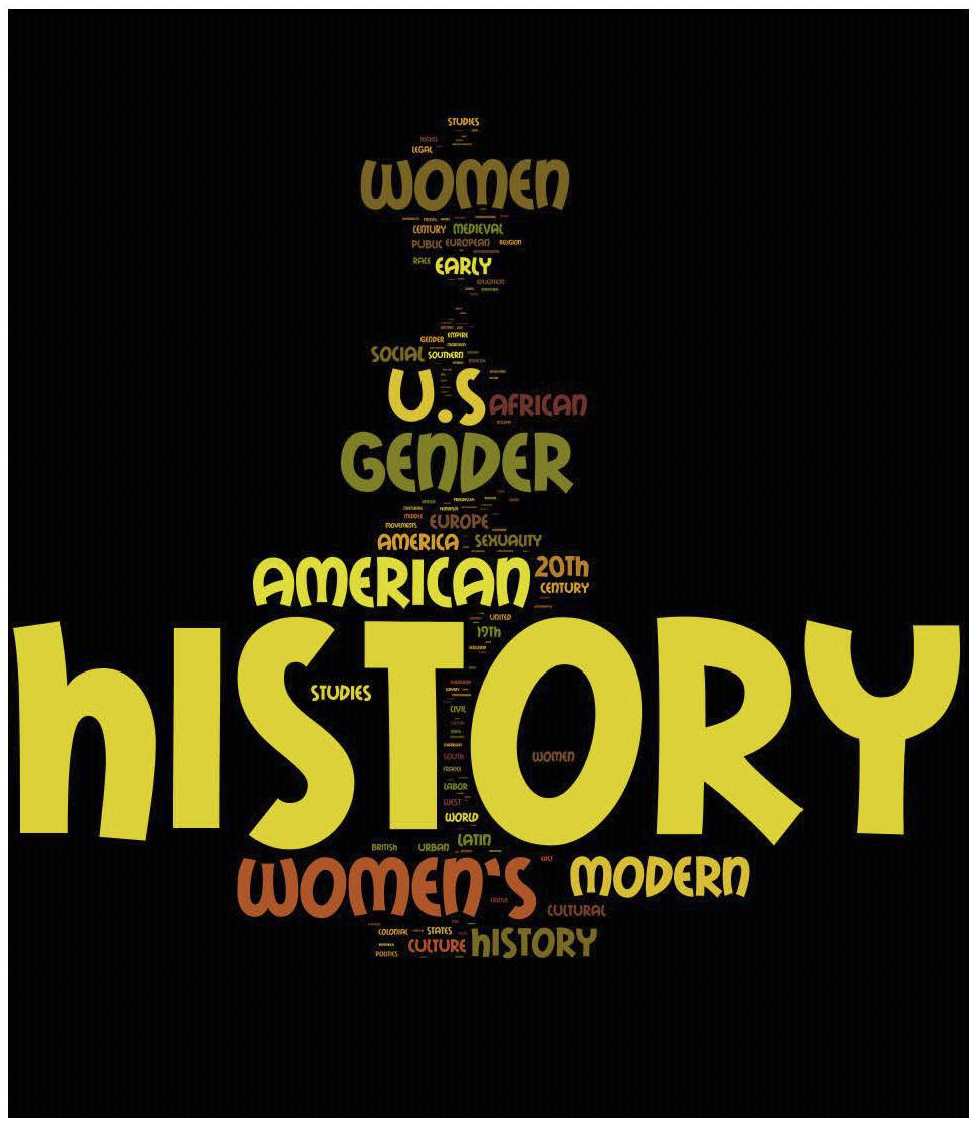
Just for fun, I also used Tagxedo to represent these key words as a map of the United States:
A review of these terms affirms my own view that women’s history is a vibrant and eclectic space, and is a strong counterpoint to those who seek to pigeonhole historians who focus on women of the past. The Center has had a wide breadth of interests since its inception, and in the future it will continue to promote diversity in the narratives it highlights in women’s education in the past. As the Center enters its new phase of growth I hope all of you will continue to support its mission to get women’s history, particularly narratives that focus on education, noticed in the exciting sphere of digital humanities.
Thank you to all of you who have interacted with me in my work at the Center, its growth is also due to your interest and promotion.
Early Entrance Exams, part 2: Bryn Mawr and the Ivy Leagues
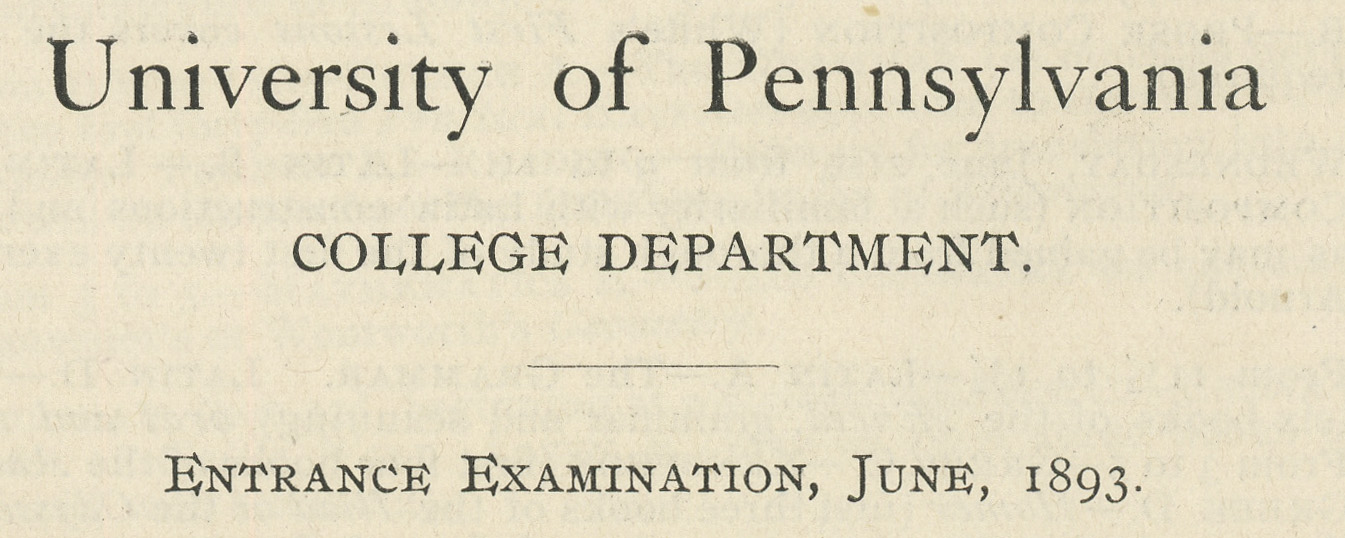 It’s the start of the new academic year, and the Greenfield Digital Center is looking forward to greeting returning students and giving a special welcome to those of you who are on campus for the first time. We know it took a lot to get here. Have you ever wondered what it would have been like to apply to college 120 years ago? Last year we published a series of early entrance examinations from the Seven Sisters, the schools (including Bryn Mawr College) that defined prestigious women’s education in the late nineteenth century. Though the institutions were all founded with slightly varying visions, they were set apart as a group from earlier models of women’s education by their mission to provide academically rigorous schooling that led to a degree. For the first time, women were being offered an academic experience that was comparable to that enjoyed by men.1
It’s the start of the new academic year, and the Greenfield Digital Center is looking forward to greeting returning students and giving a special welcome to those of you who are on campus for the first time. We know it took a lot to get here. Have you ever wondered what it would have been like to apply to college 120 years ago? Last year we published a series of early entrance examinations from the Seven Sisters, the schools (including Bryn Mawr College) that defined prestigious women’s education in the late nineteenth century. Though the institutions were all founded with slightly varying visions, they were set apart as a group from earlier models of women’s education by their mission to provide academically rigorous schooling that led to a degree. For the first time, women were being offered an academic experience that was comparable to that enjoyed by men.1
The difficulty of getting into a good college is a constant source of discussion in the twenty-first century, with admissions departments seeing incredibly high numbers of qualified applicants every year. Shouldn’t it have been easier to get into college 150 years ago, when there were fewer people applying? Not so, as we learned in the last post: even if there were only a handful of girls around the country whose parents were interested in making sure they had access to a college education, getting in was hardly a piece of cake. As our readers noticed, the entrance exams were hard—hard enough so that few of us could pass today, perhaps even after the four-year education that the exam would have qualified us to receive!
Last time we looked at how Bryn Mawr compared to the other Seven Sisters. But how would the test measure up against similar examples from the Ivy Leagues themselves? It is well documented that M. Carey Thomas, the first Dean and second President of Bryn Mawr College, aimed to make the education offered by Bryn Mawr equal in rigor to the standard American male education. Shaped by her vision, the College pursued this objective more deliberately than any of the other contemporary women’s colleges. While digging through the archives recently we came across a document describing the entrance examination for the University of Pennsylvania, as given in 1893, as well as a copy of the Harvard Examination for Women,2 also from 1893. Comparing these three documents gives us a window into how Bryn Mawr3 would have appeared alongside the schools it was designed to emulate.
The Harvard examina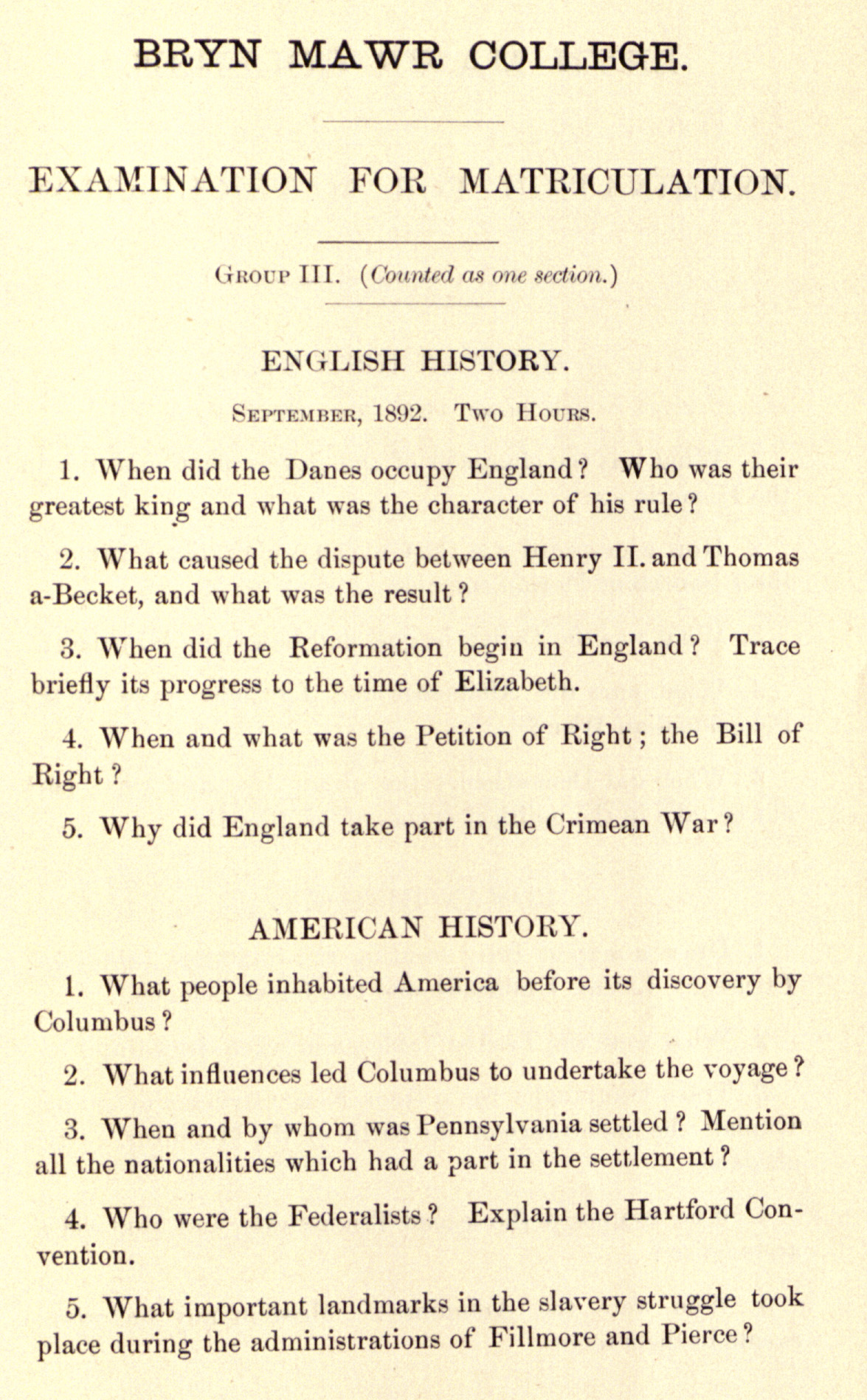
 tion and the Bryn Mawr examination have similar sections in algebra (though Harvard’s has only one section, while Penn and Bryn Mawr both feature two) and geometry. All three have a heavy focus on classical studies, which were considered to be an essential area of study in history, philosophy, literature, and languages for all serious students in the nineteenth century. The first deviation that I noticed is that a scan of Harvard’s history essay questions and Bryn Mawr’s reveal a stylistic difference: while Harvard’s requires definitions of terms and summaries of events, Bryn Mawr’s essay questions tend to be more in-depth, as you can see from the pages shown above. (The Bryn Mawr exam shown to the left, Harvard on the right. Click for an enlarged view.) The subjects covered by the different exams (as far as we can tell from the documents we have access to) are as follows:
tion and the Bryn Mawr examination have similar sections in algebra (though Harvard’s has only one section, while Penn and Bryn Mawr both feature two) and geometry. All three have a heavy focus on classical studies, which were considered to be an essential area of study in history, philosophy, literature, and languages for all serious students in the nineteenth century. The first deviation that I noticed is that a scan of Harvard’s history essay questions and Bryn Mawr’s reveal a stylistic difference: while Harvard’s requires definitions of terms and summaries of events, Bryn Mawr’s essay questions tend to be more in-depth, as you can see from the pages shown above. (The Bryn Mawr exam shown to the left, Harvard on the right. Click for an enlarged view.) The subjects covered by the different exams (as far as we can tell from the documents we have access to) are as follows:
Bryn Mawr
|
University of Pennsylvania:
|
Harvard:
|
It is difficult to make direct comparisons between the Bryn Mawr examination and the other two, considering that there are portions missing from the Harvard examination, and we only have a summary and description of the University of Pennsylvania examination. The University of Pennsylvania also had different requirements based on the division of their General Course in Science from the Course in Arts, options for specialization that the other schools did not incorporate into their exams. However, given the variances, the Bryn Mawr exam appears to require a broader command of subject matter from each candidate. For example, Bryn Mawr considered language study to be of the utmost importance, and required all candidates to be tested in Latin and two languages from Greek, German, and French. If she was not examined in all four, the candidate would be required to study a fourth language as part of her college curriculum. The University of Pennsylvania requirements, however, were narrower: candidates for the Course in Arts were examined in Latin and Greek only; candidates for the General Course in Science could elect to be tested in two 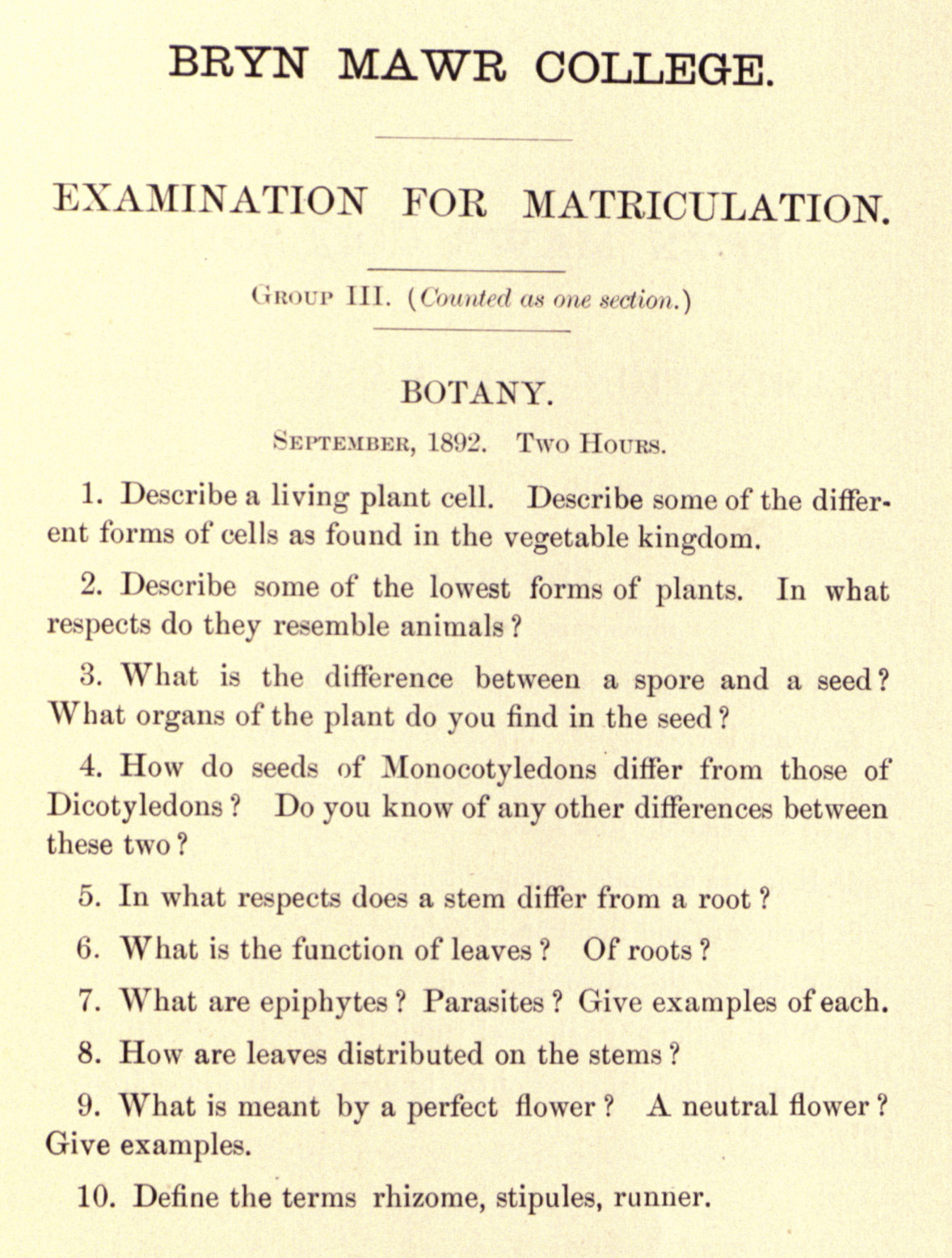 languages from Latin, French, and German, and candidates for the course in engineering were only required to know one language, either German or French. By gearing the test towards specialization in either humanities or sciences, the University of Pennsylvania thus required a narrower range of material for each candidate depending on his future area of study. Even candidates not applying to a specialized course at Bryn Mawr were required to have broad knowledge of both humanities and sciences—it appears to be the only one of the three schools that included a full section on botany. Would you have passed the section on botany based on your high school education?
languages from Latin, French, and German, and candidates for the course in engineering were only required to know one language, either German or French. By gearing the test towards specialization in either humanities or sciences, the University of Pennsylvania thus required a narrower range of material for each candidate depending on his future area of study. Even candidates not applying to a specialized course at Bryn Mawr were required to have broad knowledge of both humanities and sciences—it appears to be the only one of the three schools that included a full section on botany. Would you have passed the section on botany based on your high school education?
An in-depth look at all three examinations suggests that the Bryn Mawr examination was the most challenging, mostly because of the incredible range of the subject matter in which the candidate was expected to demonstrate competence. This was directly connected to M. Carey Thomas’s vision for the type of education the school was to provide: in a published address given in 1900, entitled “College Entrance Requirements”, Thomas firmly stated her belief that “certain studies should be taken by everyone if we have in view the creation of intellectual power.” And it was the powerful intellect, not just career preparedness, that she was interested in cultivating for her students. Another reason that she advocated breadth as well as depth of study, especially in the pre-college and early college years, was that she did not believe that intellectual proclivities would necessarily arise immediately—the student needed time to explore different options and develop her abilities. In a memorable passage from the address, she refutes a statement by President Charles Eliot of Harvard University, first quoting him in his claim that “by the seventeenth, eighteenth or nineteenth year almost every peculiar mental or physical gift which by training can be made of value is already revealed to its possessor and to any observant friend” and responding that “I believe it is very rare—and as a rule profoundly unfortunate—for a decided aptitude or bent to manifest itself before a boy or girl has been two or three years in college, and usually the consciousness of it comes much later than this.” Thomas considered a broad education to be essential for the intellectual development of her students, no matter what they specialized in. However, it is also easy to imagine that the examination was crafted to be challenging in order to prove her point that women were as capable academically as men, and that Bryn Mawr College would be the school to prove that women could be educated at a level on par or even better than that of the equivalent elite male schools.
There is one item on the examination that distinguishes Bryn Mawr from its Ivy League counterparts and provides a hint as to what kind of school the candidate was applying to. In the grammatical correction section, candidates were required to fix the wording of the following passage:
 Could it have been selected at random, or was it perhaps a nod of acknowledgment between the examiner and the candidates, aligned by a common conviction?
Could it have been selected at random, or was it perhaps a nod of acknowledgment between the examiner and the candidates, aligned by a common conviction?
Would you have passed the Bryn Mawr examination as given in 1893? Would you have preferred to take the more focused University of Pennsylvania exam, or the Harvard Examination for Women? Do you think interdisciplinary study and late specialization is an important component of the college experience? Let us know in the comments section!
To view the examinations in full, click on the following links:
- Bryn Mawr College 1892 Entrance Examination
- Harvard University Examination for Women 1893
- University of Pennsylvania Entrance Examination 1893
Footnotes
1 Furthermore, institutions like Bryn Mawr were offering access to graduate level education to women in the US, opening up the possibility of graduate study for American women without traveling to Europe for doctoral work as M. Carey Thomas had done.
2 The Harvard Examination for Women was a special case, as it was the only one that did not lead to admittance to the university issuing the test. At the time that Harvard began to give the examination, it did not admit women: the test was a way for young women to seek a certificate of academic achievement—a mark of accomplishment, rather than a ticket to the next phase of study. Though the University began offering classes to women through the Harvard Annex in 1879, it did not grant degrees to female scholars until the opening of Radcliffe College in 1894. Passage of the test was considered very prestigious, and the Bryn Mawr College entrance exam specifies that the Bryn Mawr entrance exam must be taken by all “except those who have passed in the corresponding divisions of the Harvard University Examination for Women, or who present a certificate for honorable dismissal from some college or university of acknowledged standing.”
3 We were unable to locate a Bryn Mawr College entrance examination from 1893, and will therefore be using an 1892 test for comparison.
“I’m not a historian but I am interested in people’s stories”: Lianna Reed ’14 reflects on working on Bryn Mawr College oral histories
In this guest post by Lianna Reed ’14, you can learn more about the digitization of the oral history collection held by the Special Collections department of Bryn Mawr College. As part of its work, The Albert M. Greenfield Digital Center for the History of Women’s Education is converting the audio tapes into digital files which will eventually be hosted on the Tri-College digital repository site, Triptych.
Previously, student worker Isabella Barnstein worked on the project and wrote about her experiences. We are further along with the work now and finding out more and more about alums from the past. Some of the material has been used in our Taking Her Place exhibition which can be linked to by scanning QR codes on certain labels. These include the 1935 radio broadcast by M. Carey Thomas and interviews with faculty, staff and students in the past (you can find them by clicking this link to our site). The exhibition runs until June 2nd and after this it will be made available as a digital exhibit on our site so make sure to visit the digital exhibitions section of the site ….
I have been working on the oral history project with The Albert M. Greenfield Digital Center for the History of Women’s Education for three months and not only have I learned how to digitize cassette tapes to mp3 files but I have also been absorbed into the lives of Bryn Mawr women from ten, twenty even eighty years ago. I’m not a history major or English major, in fact my academic work doesn’t usually relate to my work with Special Collections. I actually appreciate this difference because working here is a release from my academic life as a double major in Political Science and French. I get to come to work and listen to alumnae talk about their time as students in the 1940s, sneaking out of the dorms past curfew (10pm) and going to the cemetery down the road. I become immersed in the details of women who became renowned archaeologists, politicians, activists, tutors, and the list goes on and on. Oral histories are an interesting form of history because they involve someone else, usually the interviewer, prompting the interviewee to respond to certain questions. However with Bryn Mawr women, these questions are often disregarded as the women believe that they themselves aren’t interesting. I have heard so many women say “Oh, you don’t want to hear about that. It isn’t interesting.” Actually, most things are interesting, especially anecdotal commentary. Even when the women describe how challenging Bryn Mawr was and their feelings about not using the degree, prompting them to feel unworthy of their degree, it is interesting and valuable for the history archives and also for those of us that are soon to be graduates.
My first oral history was my most memorable. Fleta Blocker was a bell maid in Radnor who came to Bryn Mawr as a teenager on the recommendation of her sisters. Too young to work she was put on staff for a trial year before she was hired permanently. Fleta would end up working for forty years at Bryn Mawr College. Honored as one of the longest serving employees at Bryn Mawr, Fleta wasn’t just a bell maid, she was a friend and a student herself at Bryn Mawr. Fleta saw more change and development at Bryn Mawr than anyone else. But what does it means for Bryn Mawr’s Special Collections digital archives to have Fleta’s interview? Who will listen to her tell her story? Who will understand what it meant to her and, of course, the students, to have her there in the dorm? While Fleta’s interview is linked on the website of The Albert M. Greenfield Digital Center for the History of Women’s Education and featured in the Taking Her Place exhibition and we can track who listens and in what language, we can’t always know how they might understand Fleta’s time at Bryn Mawr in the college’s history. Maybe oral histories are like podcasts and while you can’t force anyone to listen to them, they are an integral piece of history that is accessible, not just for the Bryn Mawr community but for the community of women’s education around the world. Faculty are always celebrated for their accomplishments and their connections with publically accomplished students, but what about the other people who supported and encouraged students to become the people they are remembered to be?
What does working on this project mean for me? As I said I am not a historian but I am interested in people’s stories. I am interested in doing research in sub-Saharan Africa on the effects of transitional and restorative justice. Oral histories are one of the most important forms of archival material that we have as humans. Oral tradition is the way we know and remember songs, family history, and recipes we love to cook. Oral history and oral tradition help to clarify the ways in which restorative justice has impacted the lives of many. For example, the gacaca courts in Rwanda are an oral tradition that are both a method of enacting justice and also a form of history as the plaintiffs, witnesses and criminals participate in an open dialogue. These histories are invaluable to the success and development of Rwanda in the present day. I hope that after having listened to hundreds of different interviews from people reluctant to talk and people more than enthusiastic at Bryn Mawr I will be prepared for whatever might come my way in the field. When I am out in the field I can gather information necessary to create a dialogue, not only amongst those I am interviewing but also with the wider international community producing a discourse that gathers many people’s individual stories, much like the archives at Special Collections at Bryn Mawr College.
TONIGHT: Professor Elaine Showalter to speak as part of Taking Her Place Exhibition Program
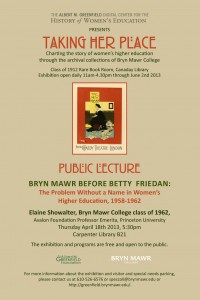 This is a reminder that The Albert M. Greenfield Digital Center for the History of Women’s Education will host Professor Elaine Showalter, Bryn Mawr College class of 1962, Avalon Foundation Professor Emerita, Princeton University at Bryn Mawr College tonight. This is part of the Friends of the Library exhibition program in which we also hosted Professor Helen Horowitz to open the show. Taking Her Place will run until June 2nd 2013, finishing with a series of dedicated tours as part of Alumnae Reunion Weekend.
This is a reminder that The Albert M. Greenfield Digital Center for the History of Women’s Education will host Professor Elaine Showalter, Bryn Mawr College class of 1962, Avalon Foundation Professor Emerita, Princeton University at Bryn Mawr College tonight. This is part of the Friends of the Library exhibition program in which we also hosted Professor Helen Horowitz to open the show. Taking Her Place will run until June 2nd 2013, finishing with a series of dedicated tours as part of Alumnae Reunion Weekend.
Professor Showalter’s talk is titled: “Bryn Mawr Before Betty Friedan: The Problem Without a Name in Women’s Higher Education, 1958-1962″.
The talk will be held on Thursday April 18th 2013 at 5:30pm in Carpenter Library B21.
Professor Showalter’s lecture will be followed by a reception at the Taking Her Place exhibition, Rare Book Room Gallery, Canaday Library, at 6.30pm. All are welcome to attend.
For directions to the campus, please see http://www.brynmawr.edu/campus/visiting.shtml
There is no need to RSVP, but please direct any questions you have about this talk to greenfieldhwe@brynmawr.edu and don’t forget to follow us on Twitter for regular updates – @GreenfieldHWE


